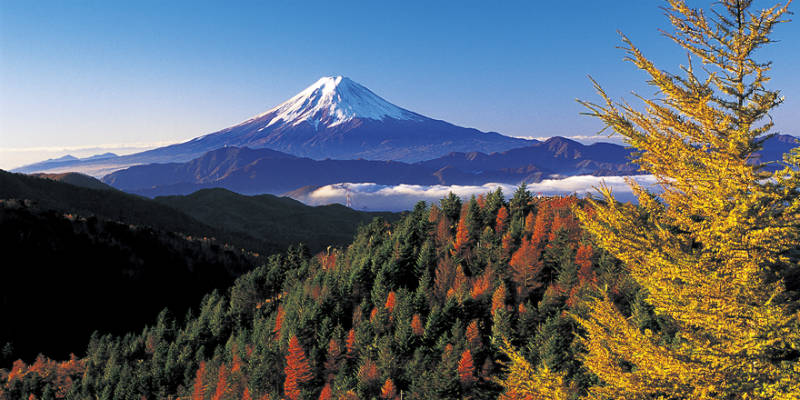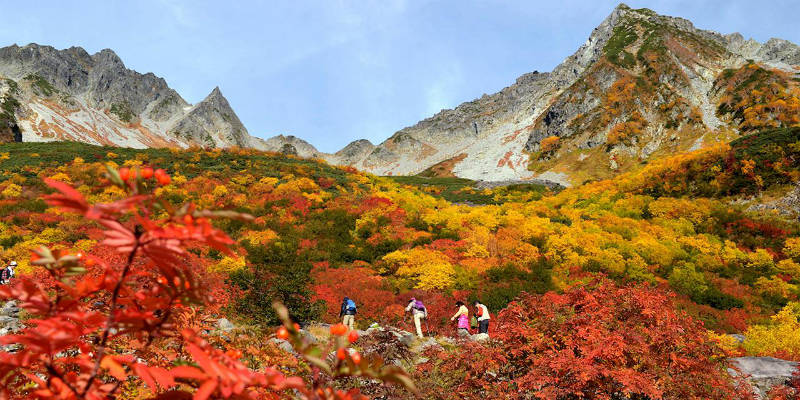Real Beauty - why you should climb Japan's mountains
If you associate mountain climbing with the European Alps or America's Rocky Mountains and are looking for a different kind of challenge, Japan may not be the first country to spring to mind. Yet Japan has some spectacular mountains to explore that will stretch any sports enthusiast and provide amazing experiences during ascent and descent.

The view of Mt. Fuji from the summit of Mt. Daibosatsu
Add to that the fascinating culture of the country, with its phenomenal food, bustling cities, and many nods to its ancient civilization and you have the perfect recipe for exploration of both physical and cultural landscapes.
Japan can be an enigmatic place for the traveler and explorer, but the sheer beauty and power of its mountains can be understood universally. You may have scaled the Eiger or Mont Blanc, but Japanese mountains have their own secrets to discover, and many thousands of people from all over the world flock to climb them, year after year.
Where should you go? In this article we offer a few suggestions to whet your appetite, peaks that are within easy reach of Tokyo. But remember that there are many, many more that you can find with a little research.
Mount Fuji
Mount Fuji is the iconic Japanese mountain, the subject of endless photos and works of art, a sacred place and a national symbol of Japan. It's Japan's highest mountain at 3,776m (over 12,000 feet) and, as with every mountain, it should be approached with knowledge as to the challenges that it presents.
Mount Fuji is to the west of Tokyo and can be seen from the capital on a clear day. It's part of the Fuji-Hakone-Izu National Park and is the park's focal point, rising up in solitary splendor as a snow-capped volcanic cone reaching towards the sky.
If you want to climb the mountain, then be aware that there is an official climbing season that only lasts for two months: July and August. This doesn't mean that you can't visit the mountain at other times, as there are plenty of lower-level trails that are open for hiking at any time of year, but if you want to head to the top out of season, then you need to be an experienced climber with knowledge of alpine conditions.
The weather is unpredictable at any time of year, so you should always get a forecast before climbing and be aware that conditions can change abruptly. Temperatures in winter can go to below -40°C, and even in the summer months, as the city below swelters in the heat and humidity, it can be below freezing at the summit.
Make sure that you prepare well for your expedition and, out of season, file a plan with the local police for an additional layer of safety. Out-of-season climbing gives the opportunity to be among only a few people, or none at all, to experience the incredible views over the landscape below - well worth the hard work to get to the top.
Ensure that your equipment and clothing are right for the climb and the temperatures - and winds - that you will endure. Climbing at this type of height may give you problems such as cold shoulder, and you should look to getting clothing that gives you back posture support as well as having all-weather gear that will protect you from whatever the elements throw at you - and this goes for every mountain adventure that you undertake.

A wooden pathway through Oze National Park, with Mt. Shibutsu in the distance
Mount Daibosatsu
If you can't make it to Mount Fuji itself, then Mount Daibosatsu can give you one of the best views of Japan's iconic mountain, as long as you have a cloudless day. It's an easy day trip from Tokyo and will give you a moderate hike, depending on where you decide to start. It's probably best to take a bus to the main starting point and head to the top to find stunning views over the landscape below, with trees and lakes drawing the eye and the ever-present Mount Fuji in the distance.
An added draw is that the mountain is right by Japan's wine country, so if you stay nearby, you can relax those tired hiking muscles with some of the country's finest offerings from fermented grapes.
Mount Shibutsu
Believe it or not, there are over 18,000 mountain peaks to explore in Japan, though it depends on how exactly you define a "mountain"! Peaks reaching over 1,000m number almost 300, and Mount Shibutsu is one that's well worth some time to explore. It's only a few hours from Tokyo and is in Oze National Park, which is in Gunma Prefecture.
It's especially well known for its alpine plants and flowers, and because of the need to protect these, the mountain is closed to hiking during May and June. The hiking season is from July to October and is reckoned to be at intermediate level during that time. If it has been raining, then be aware that part of the route to the summit can be very slippery and consequently potentially dangerous. The rocky path up is easy to follow and the view from the summit is spectacular, with blue skies and drifting clouds helping to frame the valleys below.
Going down, you follow a wooden staircase that is a lot easier than the ascent, but protection of both the mountain and its flora are important to maintain the natural beauty for people to enjoy in the future.

In the autumn, many of Japan's mountains are a riot of color
The draw of the mountains
Japanese mountains have a beauty and a dignity of their own. There may be some who think that the Himalayas or the Andes are the real challenges or, as mentioned before, the Rockies or the Alps.
All mountains have their own histories, the way they make demands on both sports enthusiasts and professional and amateur mountaineers. Though Japan may not be seen to be a leading destination for mountain climbing and tough hiking, the country has a quiet pride in its landscapes and the knowledge that discerning sports enthusiasts are always looking for new challenges in different places.
With so many mountains to explore and good access to these throughout the year, with exceptions during the winter months, Japan is more than ever a go-to country to explore many of the world's natural wonders.
Related content
